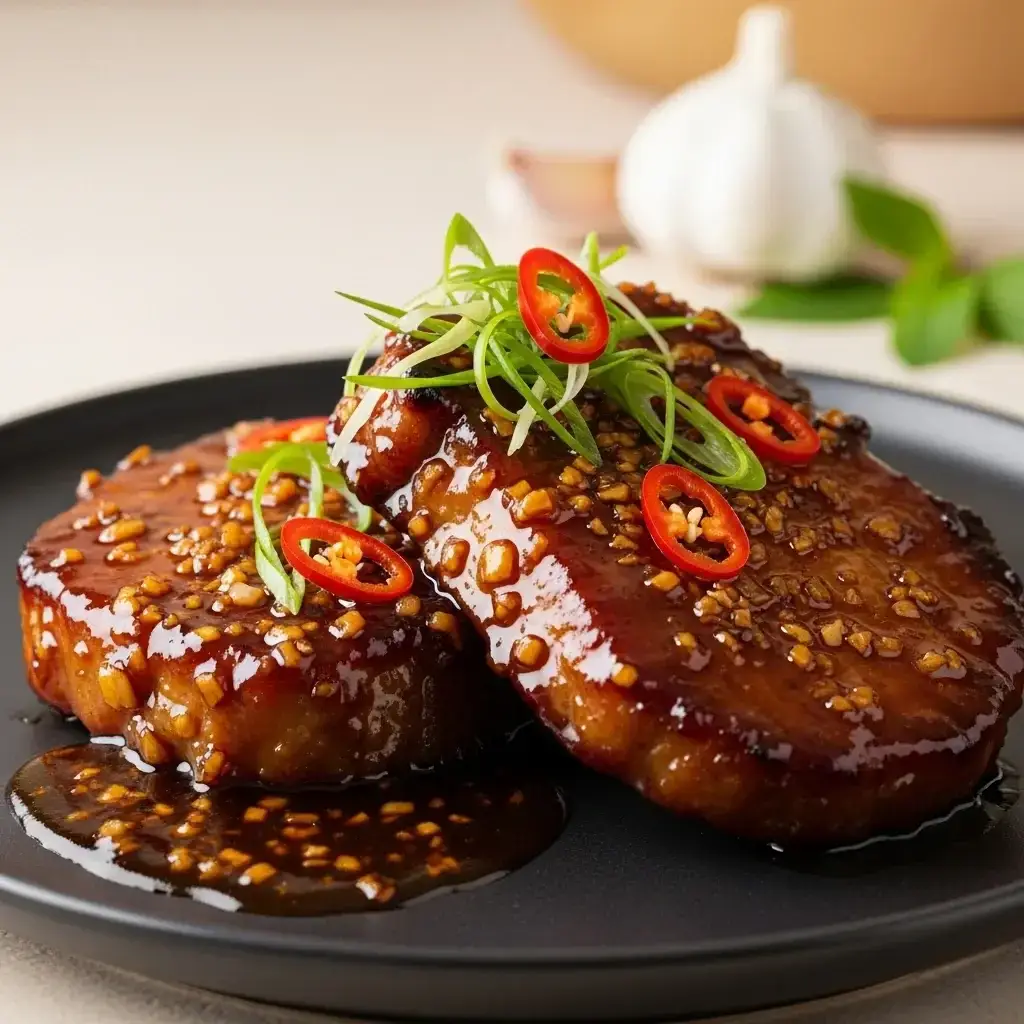











Clean the pork chops by rubbing them with salt, then rinse under cold water and pat dry. To help the pork cook evenly and absorb more flavor, you can gently pound the chops or make a few shallow cuts across the surface.
In a bowl, combine the pork chops with the minced garlic, shallots, salt, and pepper. Mix well to ensure the chops are evenly coated. Let them marinate for at least 30 minutes.
Place a large pan or skillet over medium-high heat and add the cooking oil. Once the oil is hot, carefully place the marinated pork chops in the pan. Sear for about 3-5 minutes per side, until they are golden brown and cooked through.
Add any remaining minced garlic and shallots from the marinade bowl to the pan and sauté for about 30 seconds until fragrant.
Pour the fish sauce, sugar, soy sauce, and water (or coconut water) into the pan. Bring the mixture to a boil, then reduce the heat to a medium-low simmer. Allow the pork chops to cook in the sauce, turning them occasionally, until the sauce has reduced and thickened into a beautiful, sticky glaze that coats the meat. This should take about 10-15 minutes.
Transfer the glazed pork chops to a serving platter. Drizzle any remaining sauce from the pan over the top. Garnish with sliced scallions and optional chili. This dish is best served immediately with a side of hot steamed rice.



Preheat the oven to 200°C (400°F). Arrange the baguette slices on a baking sheet, brush both sides lightly with olive oil, season with a little salt and black pepper, and toast for 6–8 minutes until golden and crisp.
In a mixing bowl combine the ricotta, finely grated garlic, lemon zest, 2 tablespoons extra-virgin olive oil, flaky salt, and black pepper; whisk until smooth and creamy, then taste and adjust seasoning or garlic intensity.
Fold the chopped Castelvetrano olives and half the toasted almonds into the ricotta mixture, keeping some almonds aside to sprinkle for texture and crunch.
Spread a generous tablespoon of the garlic-ricotta on each crostini, scatter the remaining toasted almonds and chopped oregano over the top, finish with a light drizzle of extra-virgin olive oil and a crack of black pepper, serve immediately as a zesty starter or aperitivo with chilled white wine.
Preheat the oven to 200°C (400°F). Slice the top off each head of garlic to expose the cloves, drizzle with olive oil, sprinkle with salt, wrap each head loosely in foil and roast for 30–35 minutes until the cloves are very soft and caramelized.
While the garlic roasts, arrange the sliced ciabatta on a baking sheet, brush both sides lightly with olive oil, sprinkle the chopped rosemary and a little black pepper, then toast in the oven for 8–10 minutes until golden and crisp.
When the garlic is cool enough to handle, squeeze the softened cloves from their skins and spread a small spoonful onto each crostino; top with thin slices of taleggio and a drizzle of honey if using, then return to the oven for 4–6 minutes just until the cheese melts and becomes gooey.
Remove from the oven, scatter chopped parsley over the crostini, add a final turn of black pepper, let cool slightly and serve warm as a rustic starter — ideal for sharing at any garlic shop gathering.
Place the peeled garlic cloves and olive oil in a small saucepan and warm over the lowest heat until the garlic becomes very tender and pale golden, about 25–30 minutes; season with a pinch of salt and let cool in the oil.
In a wide saucepan combine the white wine, water, lemon zest and juice, and honey (if using); bring to a gentle simmer, add a few crushed cloves of the garlic confit and the pears, then poach until the pears are just tender, 8–12 minutes depending on size.
While pears poach, toast the almonds in a dry skillet over medium heat until aromatic and lightly browned; shave or thinly slice the pecorino and chop the parsley.
Slice and toast the bread slices. Spread a little garlic confit (one softened clove per slice, mashed) onto each toasted slice to perfume the base.
Halve or slice each poached pear and arrange on the garlic-rubbed crostini; finish with shaved pecorino, chopped toasted almonds, a scatter of parsley, and a crack of black pepper.
Arrange the crostini on a platter and serve warm or at room temperature so the garlic aroma and the sweet-salty contrast shine — perfect as an elegant Italian starter for four.
In a skillet over medium heat, melt the butter, add the sliced fennel and a pinch of salt, cook until softened and beginning to caramelize, about 8–10 minutes, stir in the honey and lemon juice, cook 1–2 more minutes, then remove from heat and keep warm.
In a bowl, mash the black garlic into a smooth paste with a fork, fold into the ricotta with olive oil and lemon zest, season with salt and freshly ground black pepper and taste-adjust as needed.
Brush both sides of the bread with olive oil and grill or toast until deeply golden and crisp, for extra aroma rub each hot slice lightly with a halved clove of black garlic if desired.
Spread a generous layer of black garlic ricotta on each toast, top with a spoonful of candied fennel, scatter chopped toasted almonds and parsley, finish with a light drizzle of honey or olive oil and a squeeze of lemon, serve immediately while warm.
Wash the cucumbers and slice them paper-thin (use a mandoline if you have one); thinly slice the myoga, garlic and shiso leaves.
In a small bowl combine rice vinegar, yuzu (or lemon) juice, sugar, salt and a tiny drizzle of sesame oil if using; stir until the sugar and salt dissolve.
Toss cucumber and myoga with the salt and let sit 5–10 minutes to draw out moisture; gently press or pat dry with kitchen paper to remove excess liquid.
Combine the vegetables with the pickling liquid, add thinly sliced garlic and shiso, toss gently and sprinkle toasted sesame seeds over the top; refrigerate for at least 20 minutes (longer for deeper flavor).
Plate chilled in a shallow dish, finish with a light dusting of shichimi if desired and an extra scatter of sesame seeds; serve as a crisp, garlicky side with grilled fish, rice or as part of a bento.
In a small food processor or with a mortar and pestle, combine shiso leaves, garlic, toasted sesame seeds, yuzu zest, rice vinegar and salt; pulse while drizzling in the oil until you reach a coarse, spreadable paste — scrape down the bowl once to keep the texture bright and slightly chunky.
Sample the pesto and add a little more salt, a few drops of rice vinegar, or a touch more oil if it feels too thick — the garlic should be present but not overpowering the shiso brightness.
Arrange the arare (rice crackers) on a serving platter. If your senbei are large or very hard, optionally warm them briefly in a 150°C / 300°F oven for 3–4 minutes to refresh the crunch.
Using a small spoon or knife, dollop about 1/2 teaspoon of shiso‑garlic pesto onto each cracker; press a small piece of toasted nori on top of some for extra umami and texture contrast.
Sprinkle extra toasted sesame seeds and finely sliced shiso over the finished crackers. If you like heat, dust lightly with shichimi togarashi. Serve immediately with lemon or yuzu wedges to squeeze just before eating.
Best served the day of assembly for optimum crunch. Store leftover pesto refrigerated in an airtight jar for up to 4 days; re‑apply to freshly warmed rice crackers to revive the texture.